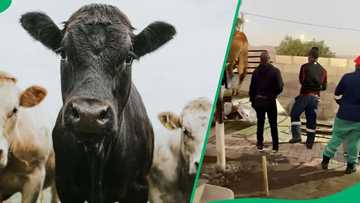FG Raises Concern on Consumption of Low Milk in Nigeria, Provides Statistics
- Nigeria's low milk consumption and heavy reliance on imports have raised concerns, with only 35 percent of national demand met through local production
- Minister of Livestock Development, Idi Mukhtar Maiha, stressed the economic and nutritional impact of this deficit during the 2025 World Milk Day celebrations in Abuja
- He urged strategic investment in dairy infrastructure, improved cattle breeding, and smallholder farmer support to boost domestic milk production and reduce dependency on imports
The Federal Government has expressed concern over Nigeria’s low milk consumption, highlighting its economic and health implications.
Minister of Livestock Development, Idi Mukhtar Maiha, made this known on Saturday, May 21, during the events marking the 2025 World Milk Day in Abuja, according to Dailytrust.

Source: Facebook
World Milk Day, established by the Food and Agriculture Organization (FAO) of the United Nations in 2001, is celebrated annually on June 1st.
The observance aims to recognise the importance of milk as a global food source and underscore the dairy sector’s contributions to sustainable agriculture, economic development, and global health.
Nigeria’s milk production deficit and economic impact
Maiha revealed that Nigeria consumes approximately 1.7 million metric tonnes of milk annually, yet local production covers only 35 percent of national demand, equating to about 600,000 metric tonnes.
“The remaining 65 percent, worth over $1.5 billion, is imported, mainly in powdered form. This dependence weakens our economy, drains foreign reserves, and limits local industry growth,” the minister said.
The minister further described Nigeria’s milk consumption rate as worrisome.
He cited World Health Organization (WHO) recommendations, which suggest an annual intake of 10 litres per person, while Nigeria’s average stands at a mere 8.7 litres—significantly below Africa’s average of 40 litres.
Challenges with indigenous cattle breeds
Maiha emphasised the challenges posed by Nigeria’s indigenous cattle breeds, which are predominantly managed by pastoralists.
These breeds yield only 1-2 litres of milk per day, in stark contrast to purebred or exotic breeds like Friesians and Jerseys, which can produce 20-30 litres daily under proper management.
Lessons from leading milk producers
Comparing Nigeria’s situation to global examples, the minister highlighted India’s success in dairy production, achieving over 200 million tonnes annually through investments in animal health and breeding technologies.
He also noted South Africa’s capacity to process over 3 billion litres of milk annually.
“India, the world’s largest milk producer, has achieved more than 200 million tonnes annually primarily from smallholder farmers through investments in animal health and breeding technologies. And closer home, South Africa processes over 3 billion litres of milk annually. These are examples Nigeria can emulate with focus and commitment,” he added.
Path forward for Nigeria’s dairy sector
Experts argue that prioritising improved cattle breeding, investment in dairy infrastructure, and support for smallholder farmers will be crucial for Nigeria to bridge the gap in milk production and consumption. The government’s renewed commitment to enhancing the dairy sector could lead to substantial economic benefits and improved nutrition nationwide.

Read also
Why Tinubu’s reforms in oil and gas regulation are worth celebrating, energy group explains
This year’s World Milk Day celebrations reinforced the urgent need for strategic investment and policy reforms to revitalise Nigeria’s dairy industry, ensuring that local production meets growing national demand.
Source: Legit.ng




